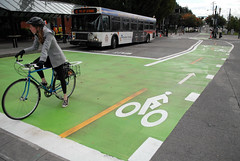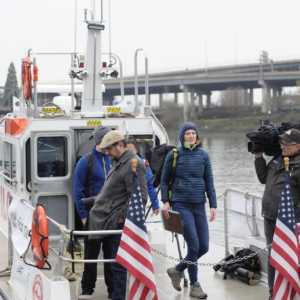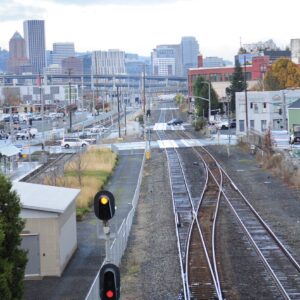According to Mike Wetter, the Senior Advisor to Metro Council President David Bragdon, the U.S. Department of Transportation is on the verge of a decision that could rapidly speed up the use of innovative bikeway treatments across America. Among supporters of a change to the policy is a national association of city transportation planners and U.S. Congressman Earl Blumenauer.
Currently, due to outdated federal standards, many bikeway designs that are common in Europe and Canada — like bike boxes, colored pavement markings, bike-only signals, and buffered bike lanes — are still considered “experimental” in the U.S.. This lack of official endorsement by the FHWA means city planners cannot use federal funds to install them and they encounter a host of significant barriers when trying to implement them. Wetter, along with transportation planners at PBOT and cities across the country, think current policies are unfair to urban jurisdictions and they might finally be close to changing them.
[Read more about efforts to work around these outdated manuals in my article about the ‘Cities for Cycling’ initiative.]
“… there is currently not a coherent national program and policy framework for cycling infrastructure in urban areas…”
— Mike Wetter, Metro
Wetter says that in part due to Metro’s work in raising this issue to DOT Secretary Ray LaHood’s office last fall, the US DOT may soon give “interim approval” to the designs which would expedite their use across the country.
On October 12, 2009, Wetter explained the “Federal barriers to active transportation” in a memo to two Obama administration officials; Assistant Secretary for Transportation Policy Polly Trottenberg and Linda Lawson, Director of the Office of Safety Energy and Environment.
Wetter wrote (emphasis mine):
“… many of the issues stem from the fact that there is currently not a coherent national program and policy framework for cycling infrastructure in urban areas. There are national programs and policy frameworks guiding automobile, air, marine and transit. The bicycle is now being regarded as a serious transportation option by many US cities and we are finding ourselves increasingly challenged by the vacuum that exists in national bicycle policy.”
A follow-up memo written by Wetter and PBOT’s head traffic engineer Rob Burchfield and bicycle coordinator Roger Geller explained that the American Association of State Highway Transportation Officials’ (AASHTO) “Guide for Development of Bicycle Facilities” and the FHWA’s Manual on Uniform Traffic Control Devices have not kept up with the times. The memo states, “These two documents provided adequate designs and traffic controls for an era when only a hardy few used bicycles for transportation.”
“It took over five years for a treatment as simple as a shared lane marking to get formally adopted. Cities are not willing to wait that long to increase citizen safety.”
The memo referred to “the onerous nature of the MUTCD” and said the current situation is “suboptimal for many reasons.” The memo goes on to state that the situation created by strict adherence to the MUTCD and AASHTO guide is “inequitable,” “risky,” “inefficient,” “expensive,” “misplaced,” “unpredictable,” “regulatory,” “slow,” and “moving backwards.”
As an example of how slow the feds are to respond to cities’ urgent needs to provide transportation services to non-motorized vehicles, the memo highlights the saga around the use and formal adoption of shared-lane markings (a.k.a. sharrows):
“The speed with which new designs are considered, debated and implemented far outpaces the ability of AASHTO and FHWA to respond under existing processes. For example, an informal count of jurisdictions across the country… found that more than 80 jurisdictions in 30 states were using shared lane markings before they were adopted into the MUTCD. It took over five years for a treatment as simple as a shared lane marking to get formally adopted. Cities are not willing to wait that long to increase citizen safety.”
These federal policy barriers have major impacts in cities like San Francisco, Chicago, Boston and Portland where bike planners and engineers want to use new tools to serve high volumes of bike traffic (in July 2008 PBOT officials filed an FHWA “request to experiment” with green colored bike boxes).
“As the Secretary himself has noted, we’ll have to move beyond current design standards if we want to create truly livable communities, where people can walk and bicycle safely.”
— Congressman Earl Blumenauer
As a solution, Wetter and his partners at PBOT want the FHWA to partner more closely with cities on research, innovation and adoption of best practices. Specifically, they want the US DOT to work in cooperation with the National Association of City Transportation Officials (NACTO, the city version of AASHTO), provide interim approval for several new (in the U.S.) bikeway designs, work with NACTO to develop the forthcoming “Cities for Cycling Urban Bikeway Design Guide” and implement the findings of an FHWA-sponsored fact-finding mission to bike-friendly cities in Europe that took place in May 2009.
Wetter says that while the interim approval has not been officially granted, the US DOT has expressed a keen interest in addressing the issue: “We appear close to achieving our first win.”
Staffers from U.S. Congressman Earl Blumenauer’s office have also been engaged with this issue. Blumenauer told me via email today that a quick adoption of best practices and design principles for transportation projects, “is essential if we are to make our roads truly safe for Americans who choose to walk and bicycle.”
Blumenauer says he has spoken with Sec. LaHood about this issue and that both of their staffs, along with transportation planners from the City of Portland, Metro, and at cities across the country are working together to find a solution. “As the Secretary himself has noted, we’ll have to move beyond current design standards if we want to create truly livable communities, where people can walk and bicycle safely.”
We’ll keep you posted if and when the interim approval is granted.







Thanks for reading.
BikePortland has served this community with independent community journalism since 2005. We rely on subscriptions from readers like you to survive. Your financial support is vital in keeping this valuable resource alive and well.
Please subscribe today to strengthen and expand our work.
It would be interesting to hear comments from FHWA and AASHTO on this. Are they purely conservative or is there more to it than that?
As I understand it, there is a debate on the safety effect of bikeways. Research suggests that they are not as safe as one might expect, especially in intersections. (The studies on that link were done before bike boxes were tried out)
On the other hand, Jacobsens safety in numbers study shows that safety for cyclists increases the more cycists there are. Which in turn suggests that the main task is to make cyclists feel more welcome on the streets.
Great reporting!
Go Blumenauer!
Research, research, research.
So much of and few definitive conclusions.
Perhaps if partisan groups were not allowed to form research studies around biased questions like “should cyclists pay a road tax?” and then call their study “an unbiased government study” we might go a long way towards getting scientific conclusions that everyone might believe.
“On the other hand, Jacobsens safety in numbers study shows that safety for cyclists increases the more cycists there are. Which in turn suggests that the main task is to make cyclists feel more welcome on the streets.”
Yep. Dresses are way under-rated cycling wear. Spandex? Over-rated.
Paul Tay, don’t forget heels.
yes, it’s a pretty girl on a bike
Meligrosa has some alternate suggestions:
Boys, boys, boys.
Why dresses beats spandex:
1) Motorists can’t claim they didn’t see da cyclist;
2) Nobody wants to tag a girl, with an air-polluting, gas-guzzling monstrosity of glass, metal, and rubber and end up as Public Enemy #1 on BikePortland;
3) Crotch stays drier, well-ventilated, and won’t get heat stroke.
but now that the sharrow has finally been approved, PBoT is using it as a wayfinder on side streets. not sure i want to see the green box on a fast track, as it is built on the principle of relegating bikes to the far right lane position.
It’s worth emphasizing, so as not to build up false hope, that US DOT is not “on the verge” of granting interim approvals to the devices mentioned in your blog post. Although these devices are being evaluated under the FHWA experimentation process, only when such evaluations are complete, and only if these devices show safety and operational benefits, will the FHWA consider interim approvals.
I agree with “are” about the bike boxes. And it’s worth thinking about this. The green boxes weren’t put in as a proper experiment, they were pushed on us. “Get behind the bike box!” was the clever double-entendre. Don’t question it, just BELIEVE!
But it, like a lot of Euro tricks, was installed without the rest of the Euro scheme – without triple priced cars, triple-priced gasoline, special traffic signals, extreme costs and tests to just get a driver’s license. And sure enough, the reports say the green boxes aren’t working. Face it, when you have bikes passing cars on the right you get trouble, no matter how pretty the paint.
Sorry, guys, when you’re designing traffic control, you shouldn’t be gazing at the pretty butterflies and thinking how wonderful the world would all be if, if, if… You’ve got to get hard nosed and analyze traffic moves in detail. That’s engineering.
And yeah, the flower-pickers will always rag on the engineers, because they think the engineers are keeping the flower fairies and butterflies out of the city. But engineers have to deal with the real world. Our blog author should do the same.
Robert T.,
you bring up some good points in your comment. I agree there are perils in adopting some parts of a Euro system when the whole network is not yet complete… but I think your judgment that the bikes boxes aren’t working. What report are your referring to. The study by PSU was pretty much inconclusive from a statistical standpoint and what it DID find was that the perception of safety has improved with the bike boxes.
portland is trying to adapt successful european treatments into an american context. it won’t be perfect and it won’t happen overnight but you’ve got to stop somewhere.
do you think we should just maintain the bikeway type status quo (bike lanes on high speed arterials) until the price of gas goes up 3X or we start finally introducing more cost into the operatioin of motor vehicles? I don’t.
Jonathan,
I may not be as cynical as Robert T but I have to agree with him on bike boxes. The design of bike boxes require bicyclists to do several dangerous maneuvers, like passing traffic on the right and passing the first car in line that could move at any moment when the light changes. Without the other safety features common with bike boxes in Europe (the advance bicycle signal phase and the “Red-Yellow” phase for motor vehicle traffic), bike boxes leave cyclists vulnerable to right hooks from motor vehicles as the cyclist approaches the box just as the light changes.
If the only thing we are improving is the PERCEPTION of safety with bike boxes then why not install a facility that both improves the perception AND actual mechanical safety for cyclists.
I’d be careful about fast-tracking bicycle innovations because there are a few (I’d say less than 10%) of them already out there that I think have real safety issues. Bike boxes are definitely one of them.
Andy B, do the bike boxes require cyclists to pass on the left? As I understand it, most jurisdictions (not Sweden) do not require cyclists to use the bikeways. I assume many cyclists keep left in intersections anyway, in which case the bike boxes probably improve visibility.
Regarding better driver education and stricter enforcement, it seems to me they go hand in hand with bikeways.
For reference, here’s a news story on a bike box study:
Are Portland’s bike boxes working? PSU study finds mixed results so far
Andy,
those are great points and I agree that simply marching forward with innovative treatments should not be done w/out rigorous analysis of whether or not the treatments put people in risky situations.
in the case of the bike boxes, i simply don’t feel they are dangerous. the stats back that up.
(and Erik, linking to an Oregonlive.com story about biking is risky. they have a long track record of wanting to stir the bike vs. anything else pot. for the record, i attended the PSU bike box unveiling and found it so inconclusive that I frankly felt it wasn’t even worth a story. in hindsight i probably should have written something anyways).
Also, who said PBOT isn’t be “careful”? Whether you approve of their work or not, there have some of the most talented and experienced bike planners and engineers in the country on staff.
And remember, no bikeway treatment can protect people at all times from all risks. i think painting bike lanes and creating laws that allow for more separation between bikes and cars at intersections is a good thing. i simply don’t buy the claim that the bike boxes have made people less safe.
non-oregonian coverage of the green box report:
http://taking-the-lane.blogspot.com/2010/01/green-box-report.html
no, the box does not “require” a cyclist to pass on the right (yet, though this could change with formal approval of the device), but it encourages that behavior (and makes people feel “safer” doing it) and it increases the motorist’s expectation that the cyclist “belongs” far to the right, over there where the magic paint is.
While the video study of the bike boxes is certainly not finished, your claim results are “inconclusive” sounds pretty fuzzy. Did the boxes reduce conflicts? From what I read, no! For now, there’s no way to call that success. No improvement from $5000 per box is failure.
And about feeling safer – Face it, the majority of people on bikes think any special treatment makes them safer, whether or not that’s true. Like the Copenhagen before-after study of cycle tracks. They caused many more crashes, but people still said they FELT safer. Same with bike lanes – people will swear “cars give me more room” even when measurements show they get LESS room.
Bike boxes? Again: Big sales job, lotsa propaganda. “Get behind them, they’re wonderful!” A year later, “Do you feel safer in these wonderful new bike boxes?” “Why yes, of course I do! And the paint color is dreamy! I’m sure I’m seeing more butterflies, too!”
Putting cyclists to the right of a right turning car is asking for trouble. It’s just nonsense. Repeal the far to right laws, repeal the mandatory bike lane laws, and bikers – take the lane! Claim your right to the road, not to the green paint!
Hi all,
I checked out that video from the Oregonian (without sound) and found it very interesting and somewhat disturbing. The close calls shown there are exactly what concerns me.
NO! Bike boxes DO NOT require cyclists to to ride past slowed or stopped cars on the right (or on the left in many places in NYC) but they greatly encourage the behavior and most novice cyclists are probably totally unaware of the hazard they are putting themselves in.
As an LCI (who is all in favor of well designed bicycle facilities BTW), I teach my students to never pass the first car waiting at a light because you just can’t predict when the driver may turn right (or left) and hook you. I say, ride up past the stopped cars safely and cautiously but wait behind the first car until the light changes, let that car go and then proceed.
I have extreme reservations about a bicycle facility that encourages cycling behavior that is contrary to what I and many other LCIs consider safe bicycle handling.
I also believe that facilities like these have the power to teach cyclists how to act and behave when facilities are not present. I personally think that Bike Boxes are teaching the wrong lesson.
Most respectfully,
Andy B
Yes, the shared-lane marking (SLM) took a long time. But it got Federal approval thanks to the efforts of the Bicycle Technical Committee of the National Committee on Uniform Traffic Control Devices (NCUTCD BTC). The SLM’s biggest problem remains that localities place it incorrectly, only now there as a standard to point to in such cases. Political compromise did allow (but not require) it to be placed a bit too close to car doors. We’re several steps ahead of where we were.
James Mackay, former Denver bicycle coordinator and originator of the shared-lane marking, is a member of the NNCUTCD BTC, as I am. He participated in a Euro scan tour and has some well-considered thoughts on bike boxes too.
Both examples make the point that it is very easy to put bicyclists at risk through design error. The approval process offers the opportunity to evaluate designs and set standards. Want to speed it up? There’s too little funding for research. I hope that politicians will put more resources behind it rather than making an end-run around it.